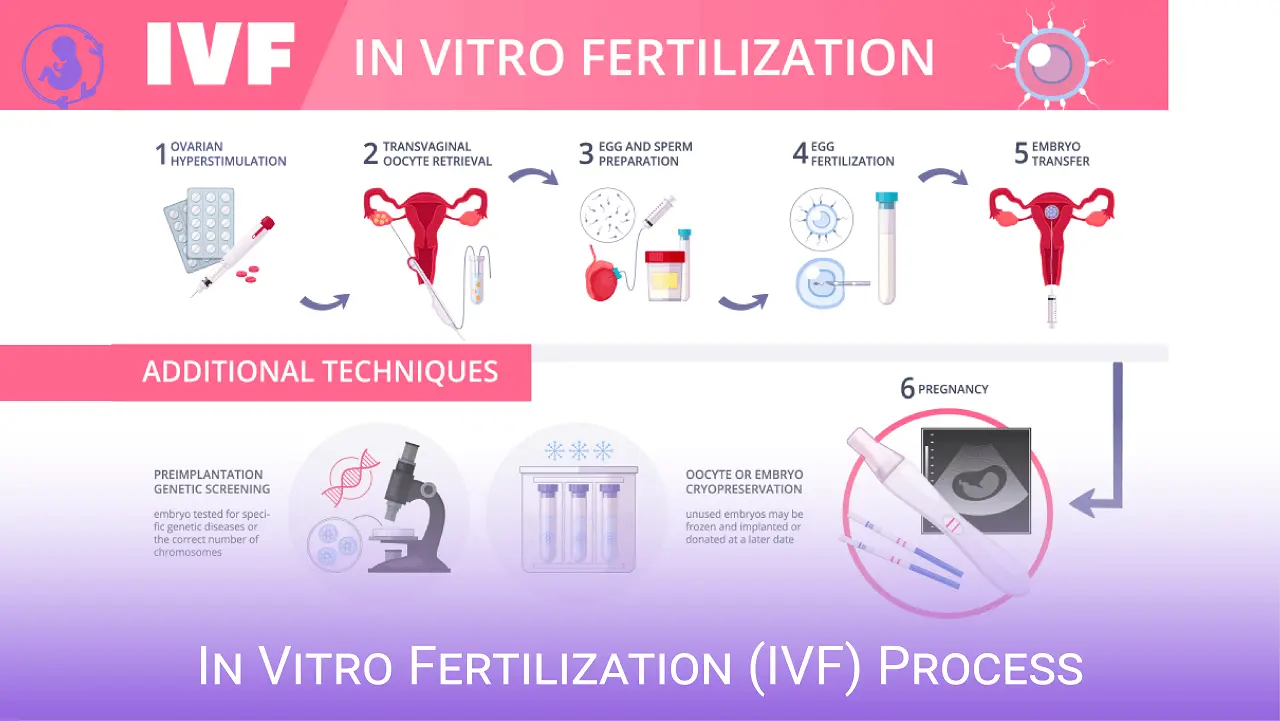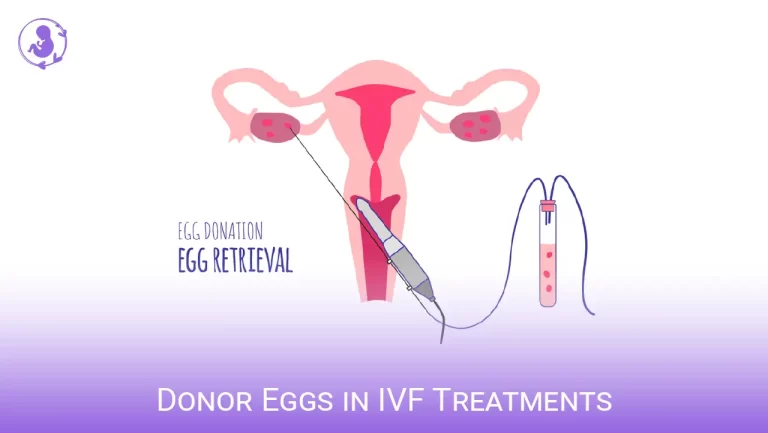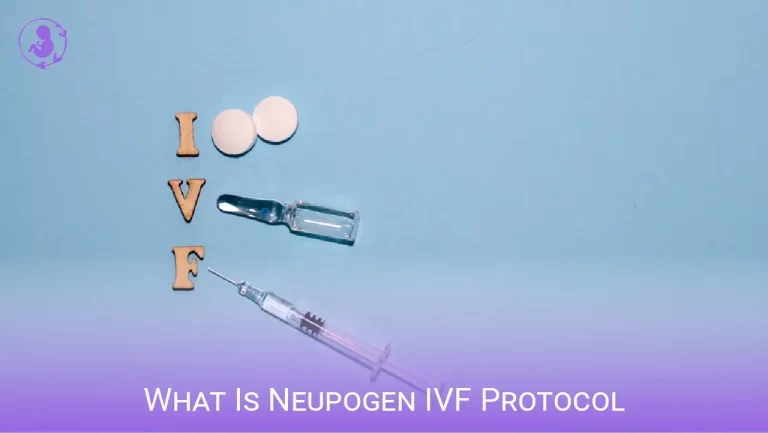In Vitro Fertilization IVF Cycle – Step by Step Process
Are you considering undergoing the in vitro fertilization (IVF) process? This complex procedure can help with fertility issues or prevent genetic problems in conceiving a child.
With IVF, eggs are removed from your ovaries, fertilized with sperm in a lab, and then transferred into your uterus. Mayo Clinic offers resources like books and a health newsletter to guide you through the process.
IVF is an effective form of assisted reproductive technology, but it can be time-consuming, expensive, and invasive.
Step 1: Day 1 of Your Period
Are you interested in learning more about the importance of menstrual tracking, hormonal changes during menstruation, and timing for optimal conception?
Tracking your menstrual cycle can provide valuable insights into your reproductive health and help you identify the most fertile days for conception.
Understanding the hormonal changes that occur during menstruation can help you better understand your body and fertility. And knowing the optimal timing for conception can increase your chances of successfully getting pregnant. Let’s dive into these topics and explore how they can support your journey towards parenthood.
Importance of Menstrual Tracking:
Understanding the importance of menstrual tracking is crucial for accurately identifying Day 1 of your period and initiating the IVF treatment cycle. Here are four reasons why menstrual tracking is essential in the step-by-step IVF process:
- Timing: Menstrual tracking allows you to determine the start of your menstrual cycle, which is crucial for beginning the IVF process on the right day.
- Medication: By tracking your menstrual cycle, you can ensure that you start the necessary medication at the appropriate time, maximizing the chances of successful egg retrieval and fertilization.
- Monitoring: Menstrual tracking helps healthcare providers monitor the development of your ovaries and follicles through ultrasounds and blood tests, ensuring that they are progressing as expected.
- Treatment planning: Accurate menstrual tracking allows your healthcare team to create a personalized treatment plan that is tailored to your specific needs and timing.
Hormonal Changes During Menstruation:
During menstruation, hormonal changes occur that can impact your mood, energy levels, and physical symptoms. These hormonal changes are an important part of the IVF cycle.
Understanding these changes can help you navigate the step-by-step process of IVF more effectively. The hormonal changes that occur during menstruation are necessary for the development and release of eggs from the ovaries.
This is an important step in the IVF process as it allows for the retrieval of eggs for fertilization. The hormones involved in this process, such as estrogen and progesterone, play a crucial role in preparing the uterus for potential embryo implantation.
It’s important to be aware of these hormonal changes and how they can affect your body and emotions. You may experience mood swings, fatigue, and physical discomfort during this time. It’s important to take care of yourself during menstruation and throughout the IVF process by getting enough rest, practicing self-care, and seeking support from your healthcare team.
Overall, understanding and managing the hormonal changes that occur during menstruation is an important part of the IVF cycle. By being aware of these changes and taking care of yourself, you can increase your chances of having a successful IVF journey.
Timing for Optimal Conception:
The timing of intercourse is crucial for optimal conception during the IVF journey. Understanding the timing is an important step in the process.
The IVF process involves multiple steps, and each step has its own timing requirements. It begins with the stimulation of the ovaries to produce more eggs. This is followed by the retrieval of the eggs, which is done in a hospital day procedure.
After the eggs are retrieved, they are fertilized with sperm in a lab. The embryos are then transferred into the uterus. Timing is crucial during each of these steps to ensure that the eggs are retrieved at the right time, fertilization occurs at the optimal time, and the embryos are transferred when the uterus is ready.

Step 2: Stimulating Your Ovaries
When it comes to IVF, understanding the medication types and dosages is crucial. Your healthcare provider will prescribe hormone medications to stimulate egg maturation, and it’s important to know the type, frequency, and dosage of these medications.
Additionally, monitoring follicle development through ultrasounds and blood tests will help track the progress of your IVF cycle.
Your partner or support person can play a vital role in providing emotional support and being involved in the process, so their involvement should be encouraged and valued.
Medication Types and Dosages:
IVF injections involve hormone medications to stimulate egg maturation, with the type, frequency, and dosage determined by the healthcare provider. These medications play a crucial role in the IVF cycle and are essential for successful egg retrieval.
Here are three important things to know about medications for ovarian stimulation in IVF:
- Types of Medications: The medications used in IVF treatment include gonadotropins, such as follicle-stimulating hormone (FSH) and luteinizing hormone (LH), which help stimulate the ovaries to produce multiple eggs. Other medications may also be prescribed to control the timing of ovulation and support the uterine lining.
- Dosage and Frequency: The dosage and frequency of IVF injections vary for each individual and are determined based on factors like age, fertility history, and response to previous treatments. Your healthcare provider will closely monitor your progress and make adjustments to the medication dosage if needed.
- Importance of Compliance: It is crucial to follow your healthcare provider’s instructions regarding medication dosage and timing. Taking the medications as prescribed will help optimize egg production and improve the chances of a successful IVF cycle.
Monitoring Follicle Development:
To ensure the success of your treatment, closely monitoring the development of your follicles is essential.
Throughout the IVF process, your healthcare provider will keep a close eye on the growth and maturation of your follicles. This is done through regular ultrasound scans, which allow your provider to measure the size of your follicles and determine if they are developing as expected.
These scans are painless and non-invasive, using sound waves to create images of your ovaries and follicles. Your provider may also adjust your medication dosage or injection schedule based on the ultrasound results to optimize follicle development.
Involvement of Partner/Support Person:
Involving your partner or a support person can provide valuable assistance and emotional support throughout the IVF journey. Going through the IVF process can be overwhelming and having someone by your side can make a big difference.
Your partner can help with the injections and medication schedule, offering a helping hand during this step-by-step IVF cycle. They can also accompany you to appointments, providing a listening ear and offering comfort during any difficult moments.
Your support person can be there to offer encouragement and be your advocate, ensuring that your needs are met throughout the process. Remember, you don’t have to go through this alone.
Lean on your partner or a support person to provide the support and assistance you need during your IVF journey.
Step 3: Egg Retrieval
When it comes to the egg retrieval process in IVF, you may have questions about the anesthesia options available to you. Understanding the different options and discussing them with your healthcare provider is important to ensure your comfort during the procedure.
Additionally, you may be curious about the recovery time after the retrieval and what to expect in terms of discomfort or side effects.
Lastly, it’s important to be aware of the risks that may be associated with the egg retrieval procedure, such as bleeding, infection, or damage to surrounding organs, so you can make informed decisions and take necessary precautions.
Anesthesia Options for Retrieval:
General anesthesia is typically given during the egg retrieval procedure in IVF. This ensures that you are completely unconscious and pain-free throughout the procedure. The anesthesia options for retrieval are discussed with your healthcare provider before the IVF process begins. They will consider factors such as your medical history, preferences, and the complexity of the procedure. The table below provides an overview of the anesthesia options commonly used during egg retrieval:
| Anesthesia Option | Description |
|---|---|
| General Anesthesia | You are completely unconscious and unaware during the procedure. It is administered through an IV or inhalation. |
| Conscious Sedation | You are given medications to relax and reduce pain during the procedure. You may be awake but in a drowsy and relaxed state. |
| Local Anesthesia | A numbing medication is injected into the area around the ovaries to minimize pain during the procedure. You remain awake and alert. |
Your healthcare provider will determine the most suitable anesthesia option for you based on your individual needs and preferences. It is important to discuss any concerns or questions you may have with your healthcare team to ensure a comfortable and successful egg retrieval procedure.
Recovery Time After Retrieval:
After undergoing the egg retrieval process as part of your IVF treatment, it’s important to give your body time to recover. The recovery time after retrieval can vary from person to person, but here are a few general guidelines to keep in mind:
- Rest: Take it easy for the first 24 to 48 hours after the procedure. Avoid strenuous activities and give your body a chance to heal.
- Pain management: You may experience some discomfort or cramping after the retrieval. Your doctor may prescribe pain medication to help alleviate any pain or discomfort.
- Follow-up appointments: It’s important to attend any scheduled follow-up appointments with your healthcare provider. They will monitor your recovery and address any concerns or questions you may have.
- Emotional support: The IVF process can be emotionally challenging. Make sure to reach out to your support system for emotional support during your recovery.
Remember to consult with your healthcare provider for personalized guidance on your recovery process after the egg retrieval procedure in your IVF journey.
Risks During Egg Retrieval:
During egg retrieval, you may experience risks such as bleeding, infection, or damage to surrounding organs. This procedure is a crucial step in the IVF process, where the eggs are collected from the ovaries.
The doctor will use a needle to carefully retrieve the eggs, ensuring the utmost care and precision. While the risks are minimal, it is important to be aware of the potential complications.
After the eggs are collected, they will be combined with sperm in a lab to create embryos. These embryos will then be transferred into the uterus to increase the chances of pregnancy.
Throughout the process, regular blood tests will be conducted to monitor hormone levels and ensure the success of the procedure. Rest assured, your healthcare team will be there to support you and minimize any potential risks during this crucial stage.
Step 4: Fertilization
In this discussion, we will explore the subtopic of fertilization in the IVF process.
You will learn about the different techniques used for fertilization, including conventional insemination and intracytoplasmic sperm injection (ICSI).
We will also delve into embryo development and selection, as well as the success rates of fertilization in IVF.
Fertilization Techniques Used:
To increase the chances of successful implantation, the technique of assisted hatching is used in IVF to create a hole in the outer shell of the embryo. This process involves the following:
- Embryo Transfer: Once the embryos have been fertilized in the lab, they are transferred into the uterus using a catheter. This is a crucial step in the IVF process, as it allows the embryos to be placed in the optimal location for implantation.
- Fertilization: Prior to the embryo transfer, the eggs are fertilized with sperm in the lab. This can be done through conventional insemination or intracytoplasmic sperm injection (ICSI), depending on the specific circumstances.
- Pregnancy Test: After the embryo transfer, a pregnancy test is typically done to determine if the IVF cycle was successful. This test usually takes place about two weeks after the transfer.
- Embryo Development: Once the embryos are transferred, they have the potential to implant into the uterine wall and develop into a pregnancy.
Embryo Development and Selection:
You can increase your chances of a successful pregnancy by understanding the process of embryo development and making informed decisions about embryo selection.
During IVF, after the mature eggs are retrieved from your ovaries, they are fertilized with sperm in a laboratory. This results in the formation of fertilized eggs, also known as embryos.
These embryos are then carefully monitored and evaluated for their development potential. The selection of the best embryo(s) for transfer is a crucial step in IVF.
By considering factors such as embryo quality, genetic testing results, and your individual circumstances, you and your healthcare team can make informed decisions about which embryos to transfer. This can greatly increase the likelihood of a successful pregnancy.
| Advantages of Embryo Selection | Emotional Impact |
|---|---|
| Increases chances of a successful pregnancy | Hopeful and excited |
| Reduces the risk of miscarriage or implantation failure | Relieved and reassured |
| Allows for the identification of genetic abnormalities | Empowered and in control |
Success Rates of Fertilization:
Now that you understand the process of embryo development and selection, let’s talk about the success rates of fertilization in the IVF process.
When it comes to IVF, the success rate is measured by the ability to fertilize an egg and achieve a live birth. The success rates can vary depending on various factors such as the age of the woman, the cause of infertility, and the quality of the embryos.
On average, the success rate for IVF is around 30-35% per cycle. However, it’s important to note that this rate can increase with multiple cycles. In fact, studies have shown that after three cycles of IVF, the success rates can go up to 50-60%.
It’s also worth mentioning that the success rates can vary from clinic to clinic. Therefore, it’s crucial to choose a reputable clinic with high success rates and experienced medical professionals to guide you through the step-by-step IVF process.
Step 5: Embryo Transfer
When it comes to the success of embryo implantation in IVF, you may be wondering about the factors that can influence it.
Additionally, you might be interested in knowing the optimal number of embryos to transfer and the timing of the embryo transfer procedure.
These key points are important considerations in the IVF process and can greatly impact the chances of a successful pregnancy.
Embryo Implantation Success:
To increase your chances of successful embryo implantation, it is important to consider factors such as maternal age, embryo quality, reproductive history, the cause of infertility, and lifestyle choices.
During the IVF process, embryo implantation is a crucial step in achieving a successful pregnancy. After the embryos have been transferred into the uterus, they need to attach to the uterine lining for implantation to occur.
The success of embryo implantation depends on various factors, including the quality of the embryo and the receptiveness of the uterine lining. Maternal age also plays a role, as older women may have a lower chance of successful implantation.
Additionally, lifestyle choices such as smoking and excessive alcohol consumption can negatively impact embryo implantation.
Optimal Number of Embryos:
For optimal embryo implantation success, it’s important to consider the number of embryos that should be transferred based on your specific circumstances and the recommendations of your healthcare provider.
Finding the optimal number of embryos for transfer is a crucial decision that can have a significant impact on the success of your IVF cycle.
Here are some important factors to consider:
- Ovarian stimulation: The number of eggs retrieved during the IVF process through ovarian stimulation can vary. This can influence the number of embryos available for transfer.
- IVF process: The step-by-step IVF cycle involves fertilizing eggs with sperm in a lab and transferring the resulting embryos into the uterus.
- Step-by-step: Each step of the IVF process, from ovarian stimulation to embryo transfer, requires careful consideration and guidance from your healthcare provider.
- Optimal number of embryos: Your healthcare provider will consider various factors, such as your age, reproductive history, and embryo quality, to determine the optimal number of embryos to transfer.
Timing of Embryo Transfer:
Now that you have learned about the optimal number of embryos for IVF, let’s discuss the timing of embryo transfer in the step-by-step IVF cycle.
Timing plays a crucial role in the success of in vitro fertilization. After the eggs are retrieved and fertilized in the lab, the embryos are carefully monitored for growth and development.
The timing of embryo transfer is determined by the IVF team based on various factors such as embryo quality, the woman’s age, and the specific circumstances of the individual. The goal is to transfer the embryos at the optimal time when the uterine lining is receptive for implantation.
The IVF team will guide you through this process, ensuring that the timing of the embryo transfer is aligned with your unique situation to give you the best chance of success.
Step 6: Pregnancy Test
When it comes to the IVF process, one of the most anticipated moments is the pregnancy test. You may wonder about the possibility of a positive pregnancy result and the excitement it can bring.
However, you should also be aware of the potential for false positive or negative results, which can be emotionally challenging. It’s important to discuss the emotional impact of these results and seek support during this time.
Positive Pregnancy Result:
If you receive a positive pregnancy result after undergoing IVF, congratulations! This is an exciting and joyful moment, especially if you have been dealing with infertility.
The IVF process can be challenging, both physically and emotionally, but the positive outcome of a successful pregnancy makes it all worth it. It is a testament to the effectiveness of the treatment plan and the dedication of the medical team that supported you throughout the journey.
Pregnancy rates with IVF vary depending on factors such as age, reproductive history, and the cause of infertility. However, overall, IVF has shown promising success rates in helping individuals and couples achieve their dream of having a baby.
Embrace this news with gratitude and excitement as you embark on the next chapter of your life.
False Positive/Negative Results:
Receiving a false positive or false negative pregnancy result can be a source of confusion and emotional distress during the IVF journey. It is important to understand that these results can occur due to various factors.
One factor is the timing of the test. If the test is taken too early after the embryo transfer, the hormone levels may not have had enough time to rise, resulting in a false negative result. On the other hand, if the test is taken too late, it may lead to a false positive result.
Another factor is the sensitivity of the test. Some tests may be more sensitive than others, which can affect the accuracy of the result. It is recommended to consult with your fertility clinic for guidance on when to take the test and which test to use to minimize the chances of false results.
Additionally, it is important to remember that the IVF process is complex and individual experiences may vary. Trusting the guidance of your healthcare provider and seeking emotional support can help navigate through any challenges that may arise.
Emotional Impact of Results:
Understanding the emotional impact of your IVF results is crucial in navigating through the ups and downs of your fertility journey. Here are some key points to consider:
1:Emotional Impact:
- IVF results can bring a range of emotions, from joy and excitement to disappointment and sadness.
- The outcome of your IVF cycle can have a significant impact on your mental well-being.
- It’s important to acknowledge and process these emotions to maintain your overall emotional health.
2:Results:
- IVF results can vary from cycle to cycle.
- You may experience positive results, such as a successful pregnancy, or negative results, such as a failed cycle or miscarriage.
- It’s important to remember that IVF is not a guarantee, and it may take multiple cycles to achieve a successful outcome.
3:Navigating the IVF Process:
- Understanding the step-by-step IVF cycle can help manage expectations and emotions.
- Having a clear understanding of the process can provide a sense of control and empowerment.
- It’s essential to seek support from your healthcare team, loved ones, or support groups to help you navigate the emotional journey of IVF.
Step 7: Follow-Up and Next Steps
Now that you have completed the IVF process, it’s important to explore your next fertility treatment options.
Discuss with your healthcare provider about the potential options that are available to you, such as additional IVF cycles, alternative assisted reproductive technologies, or even considering other paths to parenthood.
In addition, don’t forget to seek emotional support resources to help you navigate the emotional challenges that may arise during this time. Whether it’s joining support groups, seeking counseling, or leaning on loved ones, having a strong support system can make a significant difference.
Lastly, if you are planning for future pregnancies, it’s crucial to discuss with your healthcare provider about any necessary steps or precautions to take to ensure the best possible outcomes for your future pregnancies.
Next Fertility Treatment Options:
If you’re considering next fertility treatment options, there are several alternatives to IVF that you can explore. While IVF is a commonly used fertility treatment, it may not be the right choice for everyone.
Some alternative options to consider include intrauterine insemination (IUI), fertility medications, and surgery.
Intrauterine insemination involves placing sperm directly into the uterus during ovulation, increasing the chances of fertilization. Fertility medications can help stimulate egg production and regulate ovulation. Surgery may be necessary to correct structural issues in the reproductive organs.
It’s important to consult with your healthcare provider to determine the best course of action based on your individual circumstances. They can guide you through the next steps in your fertility journey and help you navigate the various treatment options available.
Emotional Support Resources:
When considering emotional support resources during your IVF journey, it’s important to explore counseling, support groups, and other avenues that can provide the guidance and support you may need. Here are four key resources to consider:
- Counseling: Seeking professional counseling can be beneficial in managing the emotional challenges that come with the IVF process. A counselor can provide a safe space to express your feelings, offer coping strategies, and help you navigate the ups and downs of the journey.
- Support Groups: Joining a support group allows you to connect with others who are going through similar experiences. Sharing your thoughts and emotions with individuals who understand can provide validation, encouragement, and a sense of community.
- Online Forums and Communities: Engaging in online forums and communities dedicated to IVF can be a valuable resource. These platforms offer the opportunity to connect with a broader range of individuals, share stories, ask questions, and gain insights from others who have been through or are currently going through the IVF process.
- Educational Materials: Utilizing educational resources such as books, articles, and podcasts can provide valuable information and guidance. They can help you better understand the IVF process, manage expectations, and empower you with knowledge to make informed decisions.
Planning for Future Pregnancies:
To plan for future pregnancies, it’s important to discuss with your healthcare provider any potential risks or considerations specific to your situation.
By discussing your future pregnancy plans with your healthcare provider, they can provide valuable guidance on timing and any necessary preparations. They can also address any concerns or risks that may be specific to your situation.
When it comes to the IVF process, understanding the steps involved can help you in planning for future pregnancies. The step-by-step IVF cycle includes identifying Day 1 of your period, stimulating your ovaries with medication, and undergoing egg retrieval.
Planning ahead can help ensure that you are well-prepared for future pregnancies and can maximize your chances of success in the IVF process.
Recap – In Vitro Fertilization IVF Cycle
So there you have it, the step-by-step process of in vitro fertilization (IVF).
From the start of your period to the exciting pregnancy test, each stage plays a crucial role in the journey towards conception.
Remember, IVF can be a complex and emotionally challenging experience, but it also offers hope to those struggling with fertility or genetic problems.
With the guidance and support of medical professionals, you can navigate through this process and hopefully achieve your dream of starting a family.
Read More On IVF






